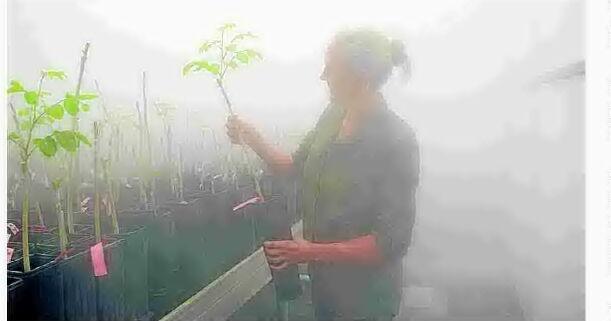An ancient tree from India is now thriving in groves where citrus trees once flourished in Florida, and could help pro-vide the United States with renewable energy. As the Sunshine State’s once-famous citrus industry all but dried up over the past two decades due to two diseases, greening and citrus canker, some farmers turned to the pongamia: a climate-resilient tree with the potential to produce plant-based proteins and a sustainable biofuel.
For years, pongamia has been used for shade trees, producing legumes that are so bitter, wild hogs won’t even eat them.
Unlike the orange and grapefruit trees that long occupied these rural Florida groves, pongamia trees don’t need much attention. They flourish in drought or rainy conditions, and don’t need fertilizer or pesticides. They also don’t require teams of workers to pick the beans; a machine shakes the little brown beans from the branches when they’re ready to harvest.
People are also reading…
Terviva, a San Francisco-based company founded in 2010 by Naveen Sikka, then uses its patented process to remove the biopesticides that cause the bitter taste, making the beans suitable for food production.
“Florida offers a rare opportunity for both Terviva and former citrus farmers. The historical decline of the citrus industry has left farmers without a crop that can grow profitably on hundreds of thousands of acres, and there needs to be a very scalable replacement, very soon,” Sikka told The Associated Press. “Pongamia is the perfect fit.”
What is the pongamia tree?
The pongamia is a wild tree native to India, Southeast Asia and Australia.
The legume is now being used to produce several products, including Panova culinary oil and protein, which are featured ingredients in Aloha’s Kona protein bars. The company also makes protein flour.
The legumes also produce oil that can be used as a biofuel, largely for aviation, which leaves a very low carbon footprint, said Ron Edwards, chairman of Terviva’s board of directors and a long-time Florida citrus grower.
Turning a wild tree into a domestic one hasn’t been easy, Edwards said.
“There are no books to read on it, either, because no one else has ever done it,” he said.
Bees and other pollinators feast on the pongamia’s flowers, supporting local biodiversity, Edwards said. An acre of the trees can potentially provide the same amount of oil as four acres of soy beans, he added.
What’s left after the oil is removed from the pongamia bean is “a very high-grade protein that can be used as a substitute in baking and smoothies and all kinds of other plant-based protein products,” Edwards said. “There’s a lot of potential for the food industry and the oil and petroleum industry.”
“We know pongamia grows well in Florida, and the end markets for the oil and protein that come from the pongamia beans — biofuel, feed, and food ingredients — are enormous,” Sikka said. “So farmers can now reduce their costs and more closely align to the leading edge of sustainable farming practices.”
At a nursery near Fort Pierce, workers skilled in pongamia grafting techniques affix a portion of the mother tree to a pongamia rootstock, ensuring the genetics and desired characteristics of the mother tree are perpetuated in all of Terviva’s trees.
Citrus was Florida’s premier crop for years until disease caught up with it starting in the 1990s with citrus canker and later greening.
Citrus canker, a bacterial disease, is not harmful to humans but causes lesions on the fruit, stems and leaves, and it eventually makes the trees unproductive.
Citrus greening slowly kills trees and degrades the fruit, according to the U.S. Department of Agriculture. Greening spread throughout Florida since 2005, devastating countless groves and reducing citrus production by 75%. The disease also spread to Louisiana, Texas and California.
Hurricane Ian caused about $1.8 billion in damage to Florida’s agriculture in September 2023, including the citrus industry.
Disease and climate issues also affected most of the world’s top citrus-producing countries. For example, this year’s harvest in Brazil — the world’s largest exporter of orange juice — is forecast to be the worst in 36 years due to flooding and drought, according to a forecast by Fundecitrus, a citrus growers’ organization in Sao Paulo state.
But climate and disease have little effect on pongamia trees, Terviva officials said.
“It’s just tough, a jungle-tested tree,” Edwards said. “It stands up to a lot of abuse with very little caretaking.”
Pongamia also grows well in Hawaii, where it now thrives on land previously used for sugarcane.
What are citrus farmers saying?
John Olson, who owns Circle O Ranch, west of Fort Pierce, replaced his grapefruit groves with 215 acres of pongamia trees.
“We went through all the ups and downs of citrus and eventually because of greening, abandoned citrus production,” Olson said. “For the most part the citrus industry has died in Florida.”
Edwards said farmers used various sprays to kill the insect that was spreading the disease. Eventually, the cost of taking care of citrus trees became too risky.
That’s when he decided to go a different route.
“What attracted me to pongamia was the fact that, one, it can repurpose fallow land that was citrus and is now lying dormant,” he said. “From an ecological point of view, it’s very attractive because it can replace some of the oils and vegetable proteins that are now being generated by things like palm oil, which is environmentally a much more damaging crop.”





